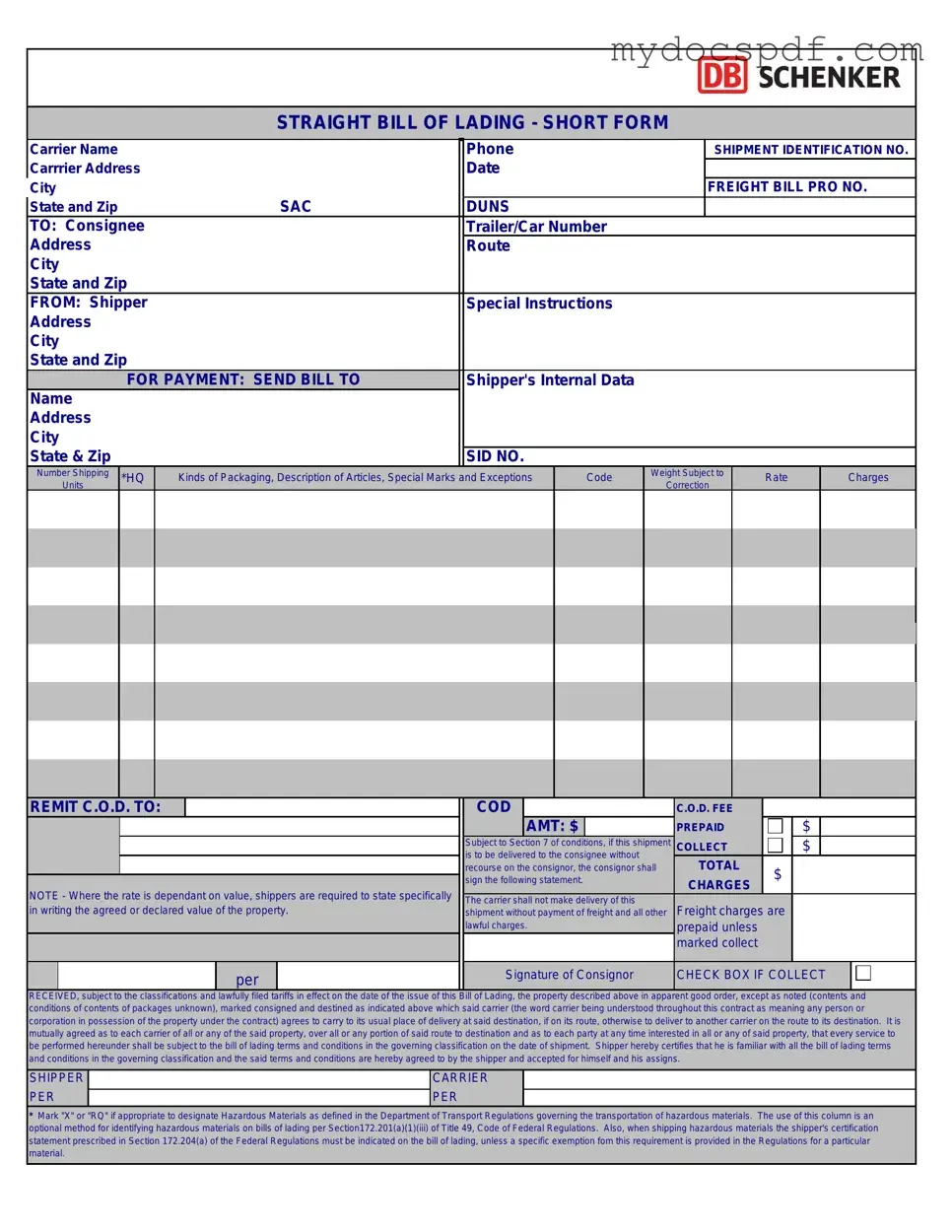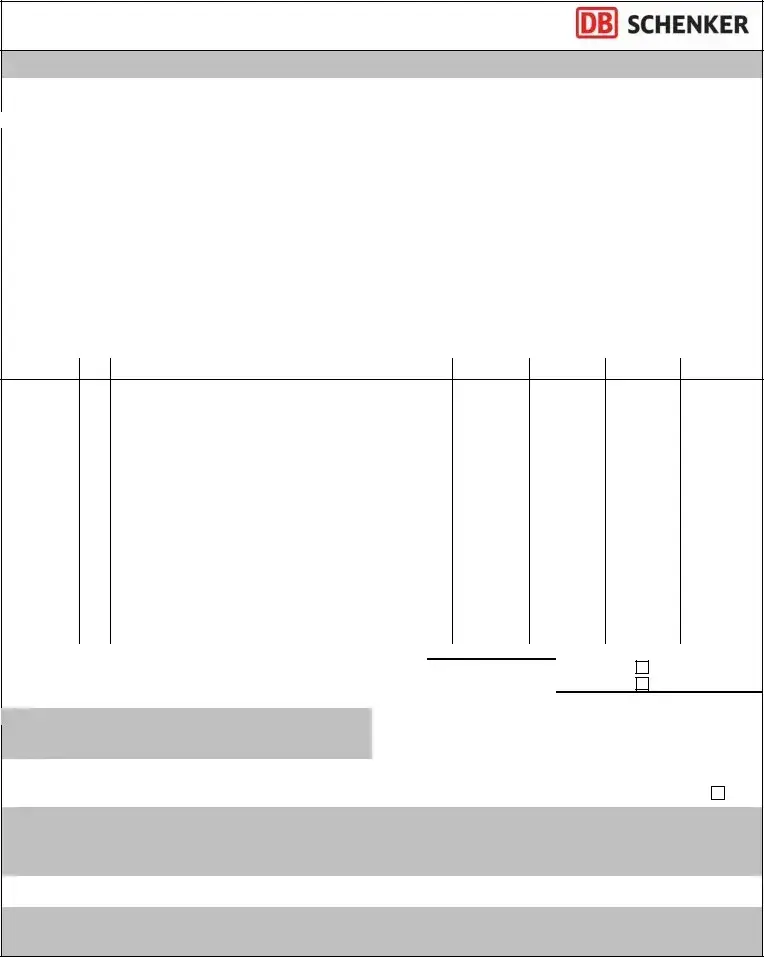STRAIGHT BILL OF LADING - SHORT FORM
Carrier Name |
|
|
Phone |
|
|
SHIPMENT IDENTIFICATION NO. |
Carrrier Address |
|
|
Date |
|
|
|
|
|
City |
SAC |
|
|
|
|
FREIGHT BILL PRO NO. |
State and Zip |
|
DUNS |
|
|
|
|
|
TO: Consignee |
|
|
Trailer/Car Number |
|
|
|
|
Address |
|
|
Route |
|
|
|
|
|
City |
|
|
|
|
|
|
|
|
State and Zip |
|
|
|
|
|
|
|
|
FROM: Shipper |
|
|
Special Instructions |
|
|
|
|
Address |
|
|
|
|
|
|
|
|
City |
|
|
|
|
|
|
|
|
State and Zip |
|
|
|
|
|
|
|
|
FOR PAYMENT: SEND BILL TO |
|
Shipper's Internal Data |
|
|
|
|
Name |
|
|
|
|
|
|
|
|
Address |
|
|
|
|
|
|
|
|
City |
|
|
|
|
|
|
|
|
State & Zip |
|
|
SID NO. |
|
|
|
|
|
Number Shipping *HQ |
Kinds of Packaging, Description of Articles, Special Marks and Exceptions |
Code |
Weight Subject to |
Rate |
Charges |
Units |
|
|
|
|
Correction |
|
|
|
|
|
|
|
|
|
|
|
|
|
|
|
|
|
|
|
|
|
|
|
|
|
|
|
|
|
|
|
|
|
|
|
|
|
|
|
|
|
|
|
|
|
|
|
|
|
|
|
|
|
|
|
|
|
|
|
|
|
|
|
|
|
|
|
|
|
|
|
REMIT C.O.D. TO: |
|
|
|
|
COD |
|
|
C.O.D. FEE |
|
|
|
|
Address |
|
|
|
|
|
|
AMT: $ |
|
PREPAID |
|
$ |
|
|
City |
|
|
|
|
|
Subject to Section 7 of conditions, if this shipment |
COLLECT |
|
$ |
|
|
State & Zip |
|
|
|
|
|
is to be delivered to the consignee without |
TOTAL |
|
|
|
|
|
|
|
|
|
recourse on the consignor, the consignor shall |
$ |
|
|
|
NOTE - Where the rate is dependant on value, shippers are required to state specifically |
|
sign the following statement. |
CHARGES |
|
|
|
|
|
|
|
|
|
|
|
|
The carrier shall not make delivery of this |
Freight charges are |
|
|
|
in writing the agreed or declared value of the property. |
|
shipment without payment of freight and all other |
|
|
|
|
|
|
|
|
|
|
lawful charges. |
prepaid unless |
|
|
|
|
The agreed or declared vlaue of the property is hereby specifically stated by the shipper to |
|
|
|
|
marked collect |
|
|
|
|
be not exceeding |
|
|
|
|
|
|
|
|
|
|
|
$ |
|
|
|
per |
|
|
Signature of Consignor |
CHECK BOX IF COLLECT |
|
RECEIVED, subject to the classifications and lawfully filed tariffs in effect on the date of the issue of this Bill of Lading, the property described above in apparent good order, except as noted (contents and conditions of contents of packages unknown), marked consigned and destined as indicated above which said carrier (the word carrier being understood throughout this contract as meaning any person or corporation in possession of the property under the contract) agrees to carry to its usual place of delivery at said destination, if on its route, otherwise to deliver to another carrier on the route to its destination. It is mutually agreed as to each carrier of all or any of the said property, over all or any portion of said route to destination and as to each party at any time interested in all or any of said property, that every service to be performed hereunder shall be subject to the bill of lading terms and conditions in the governing classification on the date of shipment. Shipper hereby certifies that he is familiar with all the bill of lading terms and conditions in the governing classification and the said terms and conditions are hereby agreed to by the shipper and accepted for himself and his assigns.
*Mark "X" or "RQ" if appropriate to designate Hazardous Materials as defined in the Department of Transport Regulations governing the transportation of hazardous materials. The use of this column is an optional method for identifying hazardous materials on bills of lading per Section172.201(a)(1)(iii) of Title 49, Code of Federal Regulations. Also, when shipping hazardous materials the shipper's certification statement prescribed in Section 172.204(a) of the Federal Regulations must be indicated on the bill of lading, unless a specific exemption fom this requirement is provided in the Regulations for a particular material.

